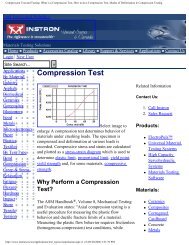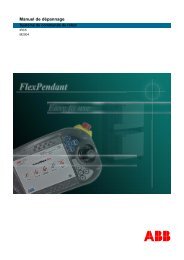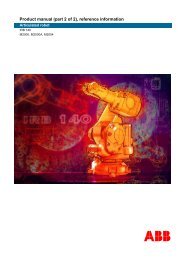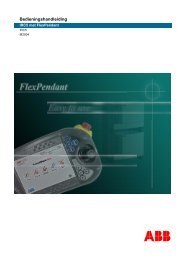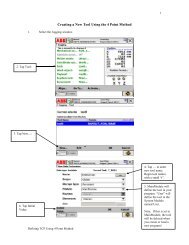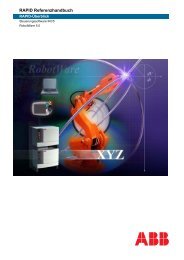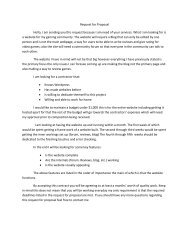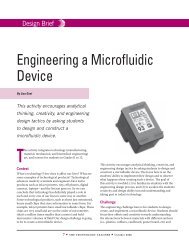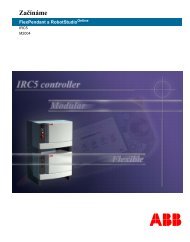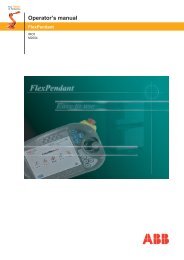Assessment Literacy Inventory.pdf - Technology
Assessment Literacy Inventory.pdf - Technology
Assessment Literacy Inventory.pdf - Technology
- No tags were found...
Create successful ePaper yourself
Turn your PDF publications into a flip-book with our unique Google optimized e-Paper software.
Measuring Teachers’ Knowledge &Application of Classroom <strong>Assessment</strong>Concepts:Development of the<strong>Assessment</strong> <strong>Literacy</strong> <strong>Inventory</strong>Craig A. Mertler, Ph.D.(mertler@bgnet.bgsu.edu)Division of Educational Foundations & InquirySchool of Educational Leadership & Policy StudiesCollege of Education & Human DevelopmentBowling Green State UniversityBowling Green, OH 43403Cynthia Campbell, Ph.D.(ccampbell@niu.edu)Department of Educational <strong>Technology</strong>, Research & <strong>Assessment</strong>Northern Illinois UniversityDeKalb, IL 60115Paper presented at the annual meeting of theAmerican Educational Research Association, Montréal, Quebec, CanadaApril 11–15, 2005Running head:Development of the <strong>Assessment</strong> <strong>Literacy</strong> <strong>Inventory</strong>…
Development of the <strong>Assessment</strong> <strong>Literacy</strong> <strong>Inventory</strong>… 3Measuring Teachers’ Knowledge & Application ofClassroom <strong>Assessment</strong> Concepts:Development of the <strong>Assessment</strong> <strong>Literacy</strong> <strong>Inventory</strong>IntroductionAccurate assessment of student achievement is being more urgentlycalled for at district, state, and national levels. Emphasis on raisingstandardized achievement scores has resulted in efforts to hold teachersaccountable for improving how student assessment is conducted in theirown classrooms. However, there exists a paradox in our educationalsystem in that many teacher preparation programs do not require a coursein classroom assessment as a requisite of graduation (Roeder, 1972;Schaefer & Lissitz, 1987; Stiggins, 1999; Wise, Lukin, & Roos, 1991). Inaddition, teachers report feeling inadequately prepared to meet thischallenge (Murray, 1991). Consequently, classroom teachers are callingfor more training due to their perceived lack of preparedness to assesstheir students, citing weaknesses in their undergraduate preparationprograms (Plake, 1993).Assessing student performance is one of the most criticalresponsibilities of classroom teachers. It has been estimated thatteachers spend up to 50 percent of their time on assessment-relatedactivities (Plake, 1993, Stiggins, 1999a). Yet, regardless of the amountof time spent, classroom assessment is a vitally important teachingfunction in that it contributes to every other teacher function(Brookhart, 1998, 1999b). According to Stiggins (1999), “The quality ofinstruction in any ... classroom turns on the quality of the assessmentsused there" (p. 20). For these reasons, information garnered fromclassroom assessments must be meaningful and accurate; i.e., theinformation must be valid and reliable (Brookhart, 1999a).In recent years, public and governmental attention has shifted toschool achievement as evidenced by performance on standardizedachievement tests (Campbell, Murphy, & Holt, 2002). Moreover, there has
Development of the <strong>Assessment</strong> <strong>Literacy</strong> <strong>Inventory</strong>… 4been an increase in expectations regarding teachers' assessmentexpertise. Teachers have been required to develop classroom assessmentsthat align curriculum with state standards as a means of improving testscores (Campbell, Murphy, & Holt, 2002). Research examining therelationship between classroom assessments and student performance onstandardized tests reveals that improving the quality of classroomassessments can increase average scores on large-scale assessments asmuch as 3/4 of a standard deviation (as much as 4 grade equivalents or15-20 percentile points), representing a huge potential (Stiggins,1999). This is important research as it makes an empirical connectionbetween the quality of teachers’ classroom assessments and students’achievement as measured by standardized tests.Yet, research has documented that teachers’ assessment skills aregenerally weak (Brookhart, 2001; Campbell, Murphy, & Holt, 2002).Stiggins (2001) is in agreement when he states that we are seeingunacceptably low levels of assessment literacy among practicing teachersand administrators in our schools. He continues by stating that thisassessment il-literacy has resulted in inaccurate assessment ofstudents, thereby, preventing them from reaching their full potential.It is ironic, that despite the increased emphasis placed oneducational testing, assessment, and data-driven decision-making in U.S.K-12 schools, many colleges of education and state education agenciesstill do not require preservice teachers to complete specific courseworkin classroom assessment (Campbell, Murphy, & Holt, 2002; O’Sullivan &Johnson, 1993). This continues to be an interesting phenomenon as manyinservice teachers report feeling ill-prepared to assess studentlearning (Plake, 1993). Furthermore, teachers often claim that theirlack of preparation is largely due to inadequate preservice training ineducational measurement (Plake, 1993). For example, in a statewidesurvey asking inservice teachers about their perceived level ofpreparedness to assess student learning resulting specifically fromtheir teacher preparation programs, over 85% of the respondents reported
Development of the <strong>Assessment</strong> <strong>Literacy</strong> <strong>Inventory</strong>… 5that they were not well prepared (Mertler, 1999). When asked about theircurrent level of preparedness, slightly more that half indicated thatthey were well prepared to assess student learning. Mertler (1999)concluded that this potentially implies that teachers tend to developassessments skills on the job, as opposed to structured environmentssuch as courses or workshops.Stiggins (1999) has reiterated this implication, stating that manyteachers are left unprepared to assess student learning as a result ofboth preservice and graduate training; they acquire what assessment“ expertise ” and skills they possess while on the job. Yet, despitebeliefs that assessment skills are developed through trial and error intheir classrooms, teachers have reported that the greatest influence ontheir assessment practices is formal coursework in tests and measurement(Wise, Lukin, and Roos, 1991).When considering teachers’ levels of assessment preparation, Plake(1993) found that over 70% of teachers responding to a national surveyreported exposure to tests and measurement content (either through acourse or inservice training), although for the majority it had beenlonger than 6 years. Inservice teachers who had previouscoursework/training scored significantly higher on a test of assessmentliteracy than those who hadn't, but the difference was less than onepoint.Recognizing the need for teachers to possess knowledge and skillsin the area of classroom assessment, a joint effort between the AmericanFederation of Teachers (AFT), the National Council on Measurement inEducation (NCME), and the National Education Association (NEA) wasundertaken in 1987 to “develop standards for teacher competence instudent assessment out of concern that the potential educationalbenefits of student assessments be fully realized” (AFT, NCME, & NEA,1990). The standards were developed to address the problem of inadequateassessment training for teachers (AFT, NCME, & NEA, 1990). The Standardsfor Teacher Competence in the Educational <strong>Assessment</strong> of Students
Development of the <strong>Assessment</strong> <strong>Literacy</strong> <strong>Inventory</strong>… 6specifies that classroom teachers should be skilled in: Choosing andDeveloping <strong>Assessment</strong> Methods; Administering, Scoring, and Interpreting<strong>Assessment</strong> Results; Using <strong>Assessment</strong> Results for Decision Making andGrading; Communicating <strong>Assessment</strong> Results; and Recognizing Unethical<strong>Assessment</strong> Practices.These Standards essentially describe the extent to which aneducator is assessment literate. “<strong>Assessment</strong> literacy ” has beendefined as follows:<strong>Assessment</strong> literate educators recognize sound assessment,evaluation, communication practices; they• understand which assessment methods to use to gatherdependable information and student achievement.• communicate assessment results effectively, whether usingreport card grades, test scores, portfolios, orconferences.• can use assessment to maximize student motivation andlearning by involving students as full partners inassessment, record keeping, and communication (Center forSchool Improvement and Policy Studies, Boise StateUniversity, n.d.).A similar description is provided by Stiggins (1995), stating that“ <strong>Assessment</strong> literates know the difference between sound and unsoundassessment. They are not intimidated by the sometimes mysterious andalways daunting technical world of assessment" (p. 240). He notes thatassessment-literate educators (regardless of whether they are teachers,administrators, or superintendents) enter the realm of assessmentknowing what they are assessing, why they are doing it, how best toassess the skill/knowledge of interest, how to generate good examples ofstudent performance, what can potentially go wrong with the assessment,and how to prevent that from happening. They are also aware of thepotential negative consequences of poor, inaccurate assessment(Stiggins, 1995).Although The Standards for Teacher Competence in the Educational<strong>Assessment</strong> of Students are somewhat dated, they continue to address manyof the important facets of classroom assessment knowledge, skills, andcompetence. However, Stiggins (1999b) asserts that these standards arenot nearly comprehensive enough in their coverage to definitivelyrepresent how to prepare teachers for the realities they will face in
Development of the <strong>Assessment</strong> <strong>Literacy</strong> <strong>Inventory</strong>… 7their classrooms and with their students. Specifically, he lists sevencompetencies, many of which are covered by The Standards. Thecompetencies listed by Stiggins (1999b) are:• Connecting assessments to clear purposes• Clarifying achievement expectations• Applying proper assessment methods• Developing quality assessment exercises and scoring criteriaand sampling appropriately• Avoiding bias in assessment• Communicating effectively about student achievement• Using assessment as an instructional intervention (pp. 25-27)While there is some debate about the extent to which The Standardsadequately address those competencies which research shows that teachersneed to possess, Table 1 shows that there is a great deal of overlap inthe original 1990 Standards and the competencies listed by Stiggins(1999b).--------------------------------------------Insert Table 1 about here--------------------------------------------In 1991, a national study was undertaken devise an instrument tomeasure teachers’ assessment literacy (Plake, 1993). The Standards wereused as a test blueprint for the development of the Teacher <strong>Assessment</strong><strong>Literacy</strong> Questionnaire used in the study. A representative sample fromaround the United States was selected to participate; a total of 98districts in 45 states surveyed, yielding a total usable sample of 555respondents (Plake, 1993). The KR20 (r KR20) reliability for the entiretest was equal to .54 (Plake, Impara, & Fager, 1993). The researchersconcluded that teachers were not adequately prepared to assess studentlearning, as evidenced by the average score of 23 of 35 items correct(66%).
Development of the <strong>Assessment</strong> <strong>Literacy</strong> <strong>Inventory</strong>… 8A similar study, conducted by Campbell et al. (2002), attempted toapply the identical previously described assessment literacy instrumentto undergraduate preservice teachers. The renamed <strong>Assessment</strong> <strong>Literacy</strong><strong>Inventory</strong> (ALI) was administered to 220 undergraduate students followingcompletion of coursework in tests and measurement. The data from theundergraduate preservice teachers exhibited a higher level ofreliability (r KR20= .74) than their inservice counterparts in the Plakeet al. study (Campbell, Murphy, & Holt, 2002). The preservice teachers(M = 21) averaged two fewer questions answered correctly than did theinservice teachers (M = 23).Mertler (2003b) studied the assessment literacy of both preserviceand inservice teachers, and then statistically compared the two groups.Using a slightly modified version of the Teacher <strong>Assessment</strong> <strong>Literacy</strong>Questionnaire, he obtained similar results to both the Plake et al.(1993) and Campbell et al. (2002) studies. The average score forinservice teachers was equal to 22 items answered correctly— q uitesimilar to the average score of 23 obtained by Plake (1993). Reliabilityanalyses also revealed similar values for internal consistency (r KR20=.54 and .57 for the original study and the study at hand, respectively).The average score for the preservice teachers was equal to 19 — alsosimilar to the average score obtained by Campbell et al. (2002).Reliability analyses revealed identical values (r KR20= .74) for internalconsistency.It is interesting to note that both the Campbell et al. (2002) andthe Mertler (2003b) study were in essence replications of the Plake(1993) study, in that both used the same original instrument developedby Plake. When the instrument was administered to inservice teachers, itdemonstrated consistent, however, poor psychometric qualities [i.e., r KR20= .54 (Plake, 1993), r KR20= .57 (Mertler, 2003b)]. When used withpreservice teachers, the instrument demonstrated identical and muchimproved reliability [i.e., r KR20= .74 (Campbell et al., 2002); r KR20= .74(Mertler, 2003b)]. Additionally, the original instrument was difficult
Development of the <strong>Assessment</strong> <strong>Literacy</strong> <strong>Inventory</strong>… 9to read, extremely lengthy, and contained items that were presented in adecontextualized way. Both Campbell et al. (2002) and Mertler (2003b)recommended a complete revision and/or redevelopment of the assessmentliteracy instrument.Purpose of the StudyThe purpose of this study was twofold: (1) to develop an instrumentthat could accurately measure teachers’ assessment literacy, and (2) todetermine the psychometric qualities of this instrument.The research questions addressed in the study were:Research Question 1: What are the psychometric properties of the<strong>Assessment</strong> <strong>Literacy</strong> <strong>Inventory</strong> (ALI) when used with preserviceteachers?Research Question 2: Could the ALI serve as a useful instrument forevaluating preservice competency in classroom assessment?MethodsDuring the spring and summer of 2003, the researchers, both withspecific expertise in issues of classroom assessment, drafted aninstrument titled the <strong>Assessment</strong> <strong>Literacy</strong> <strong>Inventory</strong>, hereafter referredto as the ALI. The ALI consisted of 35 items, embedded within fiveclassroom-based scenarios, featuring teachers who were facing variousassessment-related decisions. An example of one of the scenarios,including three of its seven items, is provided in the Appendix in orderto give the reader an idea of the contextualized nature of theclassroom-based scenarios and related items as they appear on the ALI.Each scenario presented a brief classroom situation followed by sevenmultiple-choice items. Each of the seven items within a single scenariowere written to directly align to one of the seven Standards for TeacherCompetence in the Educational <strong>Assessment</strong> of Students (AFT, NCME, & NEA,1990). Following item construction, items were reviewed by theresearchers, to check for alignment with the standards, as well as
Development of the <strong>Assessment</strong> <strong>Literacy</strong> <strong>Inventory</strong>… 10clarity, readability, and accuracy of keyed answers. Items that raisedquestions regarding alignment, clarity, wording, or correctness ofanswer were revised. Judgmental review continued until consensus wasreached regarding item appropriateness and quality.During fall of 2003, an initial pilot test was conducted withundergraduate preservice teachers enrolled in introductory classroomassessment courses. One hundred fifty-two preservice teachers from thetwo large Midwestern institutions completed the ALI in an attempt tomeasure their assessment literacy. It is important to note that theundergraduate introductory assessment courses are a requirement forgraduation at both institutions, and that course content, objectives,assignments, and experiences are designed to align with the sevenStandards for Teacher Competence in the Educational <strong>Assessment</strong> ofStudents (AFT, NCME, & NEA, 1990). In addition, students from bothinstitutions take the required assessment course prior to studentteaching.A complete item analysis was conducted on the resulting data usingthe Test Analysis Program (TAP) (Brooks & Johanson, 2003). Analysesincluded overall test analysis, individual item analyses, reliabilityanalyses, and options (i.e., distractors) analysis.Following an examination of the item analysis, the researchers madeappropriate revisions to items appearing on the ALI. A second phase ofdata collection occurred in the spring of 2004 with 250 undergraduatesfollowing their completion of tests and measurement coursework. Analysesof the data were conducted using SPSS (v. 11) and TAP (v. 5.2.7).ResultsThe initial pilot test of the <strong>Assessment</strong> <strong>Literacy</strong> <strong>Inventory</strong> with152 preservice teachers revealed an overall KR20 (r KR20) reliability equalto .75. The mean item difficulty was equal to .64 and the mean itemdiscrimination was equivalent to .32. These values indicate that the ALIappeared to function reasonably well, from a psychometric perspective.
Development of the <strong>Assessment</strong> <strong>Literacy</strong> <strong>Inventory</strong>… 11Further reliability analyses revealed that only four of the 35 items,when removed from the scale, resulted in an improved overallreliability. Based on this fact, the instrument was slightly revised inan attempt to improve its overall reliability, as well as otherpsychometric properties.The second phase of pilot testing with the revised ALI wasconducted following Spring 2004. To determine the appropriateness ofanalyzing data from the two institutions together, we establishedinstitutional similarity by examining the means, standard deviations,and reliability coefficients, as well as statistically comparing thetotal scores on the ALI across the two groups (see Table 2). Afterdeleting outliers with standardized total scores (i.e., z-scores)exceeding +/-3.00 (of which there was only one case), the total scoreswere compared for the first (M = 24.50, SD = 4.92) and second (M =22.98, SD = 4.05). No significant difference was found between total ALIscores for the two institutions, t(247) = 2.558, p>.01, two-tailed.--------------------------------------------Insert Table 2 about here--------------------------------------------Examination of the item analysis results from this phase revealed avalue similar to that resulting from the first phase for instrumentreliability, r KR20= .74. Across the 35 items appearing on the ALI, itemdifficulty values ranged from a low of .212 to a high of .992; the meanitem difficulty was equal to .681. The entire distribution of difficultyvalues is presented in Figure 1.--------------------------------------------Insert Figure 1 about here--------------------------------------------Across the 35 items appearing, item discrimination values rangedfrom a low of .014 to a high of .641; the mean item discrimination was
Development of the <strong>Assessment</strong> <strong>Literacy</strong> <strong>Inventory</strong>… 12equal to .313. The entire distribution of difficulty values is presentedin Figure 2.--------------------------------------------Insert Figure 2 about here--------------------------------------------Additionally, the analysis showed that only three— I tems 17, 21,and 32 — of the 35 items, when removed from the scale, resulted in animproved overall reliability. Furthermore, it is important to note thatthese improvements in overall reliability were extremely small (i.e.,+.001, +.003, and +.002, respectively, for the three items).DiscussionThe psychometric qualities of the ALI strongly support its use asan acceptable measure of teachers’ assessment literacy. The fact thatthe ALI demonstrated an overall reliability coefficient of .74 isconsistent with recommendations in the literature regarding measureswhich result in high or good reliability. For example, Kehoe (1995)recommends that reliability values as low as .50 are satisfactory forshort tests (10-15 items), though tests with over 50 items should yieldKR-20 values of .80 or higher. Chase (1999) has suggested that for thistype of test, reliability coefficients should be no lower than .65, butpreferably higher. Similarly, Nitko (2001) advocates for reliabilitycoefficients that range between .70 and 1.00. With its 35 items, theoverall reliability demonstrated by the ALI in this study place theinstrument well within these ranges.Considering characteristics of individual items on the ALI alsoseem to demonstrate the instrument’s effectiveness. With respect to itemdifficulty, Kehoe (1995) states that, on a good test, most [emphasisadded] items on a test will be answered correctly by 30% to 80% of theexaminees. On the ALI, 25 of the 35 items fell within this range. Chase(1999) recommends a slightly broader range for effective itemdifficulties — from .20 to .85; 28 of ALI’s items fell within this range.
Development of the <strong>Assessment</strong> <strong>Literacy</strong> <strong>Inventory</strong>… 13The seven remaining items showed higher difficulty levels (i.e., theywere “easier ” items). Mertler (2003a) argues that on a criterionreferencedtest — such as the ALI — a high difficulty level is a goodthing as it serves as a clear indicator that examinees have mastered aspecific concept.Finally, with respect to item discrimination, Chase (1999) statesthat discrimination values of .30 and higher indicate fairly good itemquality. Twenty of the 35 items appearing on the ALI had discriminationvalues greater than .30. It should be noted that of the remaining 15items, 7 had fairly high difficulty levels (> .80). For items on whichthe vast majority of examinees identify the correct answer (i.e., thedifficulty value is high), one could not expect to have gooddiscrimination between the high and low scoring groups; it is notmathematically possible. Since both groups would achieve similardifficulty values, there would be very little discrepancy betweenrespective difficulty values (i.e., the discrimination value would below).When examining preservice teachers’ overall performance on the ALI,it should be noted that their score was far lower than might otherwisebe expected given their recent completion of coursework in classroomassessment. Despite explicit efforts to link course content,assignments, and experiences characteristic of educational decisions andpractices outlined in The Standards for Teacher Competence in theEducational <strong>Assessment</strong> of Students (AFT, NCME, & NEA, 1990), preserviceteachers’ mean score was 23.83 out of a possible 35 points, orapproximately 68% of items answered correctly. Possible reasons for theobserved gap between their ALI performance and recent formal trainingmay be related to preservice teachers’ limited classroom experience.Perhaps because the ALI is specifically designed to measure the realworldapplications of assessment concepts and competencies outlined inThe Standards, limited familiarity and experience with the day-to-day
Development of the <strong>Assessment</strong> <strong>Literacy</strong> <strong>Inventory</strong>… 14realities of the classroom may have precluded preservice teachers frommaking necessary connections.The role of teaching experience may be too important to overlook.For example, following a two-week, intensive professional developmenttraining course in classroom assessment, a small group of inserviceteachers (n = 7) completed the ALI as a measure of assessment skills andknowledge. Similar to preservice teachers in the present study, theinservice teachers had not had previous coursework in classroomassessment. Although the ALI was administered following formalinstruction in both groups, average test scores of inservice teacherswere much higher (i.e., 28.29 out of a possible 35 points, orapproximately 81% of items answered correctly) than scores of thisstudy’s preservice teachers tested under similar conditions. While theinservice sample is too limited to claim a link between first-handteaching experience and assessment competency, it may, however,highlight the importance of experience in providing an importantcontextual base for transforming theory (with potentially abstractconcepts) into real-world practice. Research is needed to examine theextent to which teaching experience influences the development ofassessment competency (as measured by the ALI) by comparing preservicegroups who complete assessment coursework at different points in theirteacher preparation program. Examining the assessment skills of studentsfrom teacher education programs that vary the placement and sequencingof assessment coursework (e.g., before, during, or following studentteaching) may help to disentangle the effects of experience on acquiringassessment skills as applied to educational decision making.Although when used with preservice teachers the reliability of thePlake and Impara instrument produced similar reliability to the ALI, theuser friendly format of the ALI (seven items relating to a singlescenario for a total of 5 scenarios, 35 items) may reduce cognitiveoverload associated with reading 35 unrelated items, each containing itsown unique scenario description. Moreover, the ALI may likely be more
Development of the <strong>Assessment</strong> <strong>Literacy</strong> <strong>Inventory</strong>… 15appealing to the test taker because of the 35 item’s thematic connectionto a running story. Consequently, test takers may be more motivated andwilling to complete the ALI. Still, we recognize that further researchusing the ALI with preservice teachers is needed to identify ways toimprove reliability and establish validity evidence. Construct validityevidence is currently being examined through confirmatory factoranalysis to identify whether the proposed 7-factor structurecorresponding to The Standards for Teacher Competence in the Educational<strong>Assessment</strong> of Students is observed. To determine concurrent validityevidence, the connection between preservice teachers’ ALI score andtheir end of semester percentage points earned in assessment courseworkis currently being examined.Moreover, it is recommended that further studies also be undertakento ascertain the appropriate use of the ALI as a measure of inserviceteacher assessment literacy, as well. Although some preliminary work inthis area has been explored, formal studies of the validity,reliability, and appropriateness of the ALI as a measure of inserviceteacher assessment literacy could potentially lend credibility to itsuse as a diagnostic instrument, specifically geared toward theidentification — and ultimate remediation— o f classroom assessmentweaknesses or misconceptions.The day-to-day work of classroom teachers is multifaceted, to saythe least. However, none of these daily responsibilities is moreimportant— o r more central — t o the work of teachers than that ofassessing student performance (Mertler, 2003a). Previous studies havereported that teachers feel — a nd actually are — unprepared to adequatelyassess their students (e.g., Mertler, 1999, 1998; Plake, 1993). Theyoften believe that they have not received sufficient training in theirundergraduate preparation programs to feel comfortable with their skillsin making assessment decisions.The <strong>Assessment</strong> <strong>Literacy</strong> <strong>Inventory</strong> provides a mechanism foreducators to measure assessment literacy (i.e., their knowledge of and
Development of the <strong>Assessment</strong> <strong>Literacy</strong> <strong>Inventory</strong>… 16abilities to apply assessment concepts and techniques to informdecision-making and guide practice). Considering the current state ofhigh-stakes accountability in education, the ALI could provide schooldistricts an effective, as well as efficient way to allocate resourcesfor developing or otherwise selecting teacher professional developmentopportunities on the topic of classroom assessment. Because the ALI isbased entirely on the Standards for Teacher Competence in theEducational <strong>Assessment</strong> of Students, its use could provide educationalleaders with a diagnostic tool for identifying areas (i.e., asrepresented by a given standard) where teachers may be deficient and inneed of further remediation and training. In this way, such effortscould provide school districts with a roadmap for facilitating teachers’knowledge and application of assessment concepts and techniques, therebyimproving the accuracy of educational decisions contributing to studentlearning and school improvement.
Development of the <strong>Assessment</strong> <strong>Literacy</strong> <strong>Inventory</strong>… 17ReferencesAmerican Federation of Teachers, National Council on Measurement inEducation, & National Education Association. (1990). The Standardsfor Competence in the Educational <strong>Assessment</strong> of Students. RetrievedJuly 22, 2003, from http://www.unl.edu/buros/article3.htmlBrookhart, S. M. (1998). Teaching about grading and communicatingassessment results. Paper presented at the annual meeting of theNational Council on Measurement in Education, San Diego, CA. (ERICDocument Reproduction Service No. 419838)Brookhart, S. M. (1999a). The art and science of classroom assessment: Themissing part of pedagogy. Washington, D.C.: ERIC Clearinghouse onHigher Education and Office of Educational Research and Improvement.Brookhart, S. M. (1999b). Teaching about communicating assessment resultsand grading. Educational Measurement: Issues and Practice, 18(1), 5-13.Brookhart, S. M. (2001). The Standards and classroom assessment research.Paper presented at the annual meeting of the American Association ofColleges for Teacher Education, Dallas, TX. (ERIC DocumentReproduction Service No. ED451189)Brooks, G. P., & Johanson, G. A. (2003). Test Analysis Program. AppliedPsychological Measurement, 27, 305-306.Campbell, C., Murphy, J. A., & Holt, J. K. (2002, October). Psychometricanalysis of an assessment literacy instrument: Applicability topreservice teachers. Paper presented at the annual meeting of theMid-Western Educational Research Association, Columbus, OH.Center for School Improvement and Policy Studies, Boise State University.(n.d.). What is assessment literacy? In <strong>Assessment</strong> literacy.Retrieved July 24, 2003, from http://csi.boisestate.edu/al/Chase, C. I. (1999). Contemporary assessment for educators. New York:Longman.
Development of the <strong>Assessment</strong> <strong>Literacy</strong> <strong>Inventory</strong>… 18Kehoe, J. (1995). Basic item analysis for multiple-choice tests. Practical<strong>Assessment</strong>, Research & Evaluation , 4(10). Retrieved August 18, 2004from http://PAREonline.net/getvn.asp?v=4&n=10.Mertler, C. A. (1999). Assessing student performance: A descriptive studyof the classroom assessment practices of Ohio teachers. Education,120(2), 285-296.Mertler, C. A. (2000). Teacher-centered fallacies of classroom assessmentvalidity and reliability. Mid-Western Educational Researcher, 13(4),29-35.Mertler, C. A. (2003a). Classroom assessment: A practical guide foreducators. Los Angeles, CA: Pyrczak.Mertler, C. A. (2003b, October). Preservice versus inservice teachers’assessment literacy: Does classroom experience make a difference?Paper presented at the annual meeting of the Mid-Western EducationalResearch Association, Columbus, Ohio.Murray, D. R. (1991). An analysis of the perceptions of teacher educationgraduates on their preparation for service: A five year review. EricDocument: ED335349.Nitko, A. J. (2001). Educational assessment of students. Upper SaddleRiver, NJ: Merrill.O'Sullivan, R. G. & Johnson, R. L. (1993). Using performance assessments tomeasure teachers' competence in classroom assessment. Paper presentedat the annual meeting of the American Educational ResearchAssociation, Atlanta, GA. (ERIC Document Reproduction Service No.358156)Plake, B. S. (1993). Teacher assessment literacy: Teachers' competencies inthe educational assessment of students. Mid-Western EducationalResearcher, 6(1), 21-27.Plake, B. S., Impara, J. C., & Fager, J. J. (1993). <strong>Assessment</strong> competenciesof teachers: A national survey. Educational Measurement: Issues andPractice, 12(4), 10-12, 39.
Development of the <strong>Assessment</strong> <strong>Literacy</strong> <strong>Inventory</strong>… 19Roeder, H. H. (1972). Are today's teachers prepared to use tests?Peabody Journal of Education, 49(3). 239-240.Schaefer, W. D., & Lissitz, R. W. (1987). Measurement training forschool personnel: Recommendations and reality. Journal of TeacherEducation, 38(3), 57-63.Stiggins, R. J. (1995). <strong>Assessment</strong> literacy for the 21st century. Phi DeltaKappan, 77(3), 238-245.Stiggins, R. J. (1999). Are you assessment literate? The High SchoolJournal, 6(5), 20-23.Stiggins, R. J. (2001). The unfulfilled promise of classroom assessment.Educational Measurement: Issues and Practice, 20(3), 5-15.Wise, S. L., Lukin, L. E., & Roos, L. L. (1991). Teacher beliefs abouttraining in testing and measurement. Journal of Teacher Education,42(1), 37-42.
Development of the <strong>Assessment</strong> <strong>Literacy</strong> <strong>Inventory</strong>… 20Table 1. Comparison of Stiggins’ (1999b) Classroom <strong>Assessment</strong>Competencies and The Standards for Teacher Competence in theEducational <strong>Assessment</strong> of Students (1990)Stiggins (1999b) CompetenciesThe Standards for TeacherCompetence in the Educational<strong>Assessment</strong> of Students (1990)Standard 1: Teachers should beskilled in choosing assessmentmethods appropriate forinstructional decisions.Competence 1: Connectingassessments to clear purposesStandard 2: Teachers should beskilled in developing assessmentmethods appropriate forinstructional decisions.Standard 4: Teachers should beskilled in using assessmentresults when making decisionsabout individual students,planning teaching, developingcurriculum, and schoolimprovement.(Also addressed in section titledThe Scope of a Teacher’sProfessional Role andResponsibilities for Student<strong>Assessment</strong>)Competence 2: Clarifyingachievement expectationsStandard 4: Teachers should beskilled in using assessmentresults when making decisionsabout individual students,planning teaching, developingcurriculum, and schoolimprovement.(Also addressed in section titledThe Scope of a Teacher’sProfessional Role andResponsibilities for Student<strong>Assessment</strong>)Competence 3: Applying properassessment methodsStandard 1: Teachers should beskilled in choosing assessmentmethods appropriate forinstructional decisions.Standard 2: Teachers should beskilled in developing assessmentmethods appropriate forinstructional decisions.
Development of the <strong>Assessment</strong> <strong>Literacy</strong> <strong>Inventory</strong>… 21Table 1 (continued). Comparison of Stiggins’ (1999b) Classroom<strong>Assessment</strong> Competencies and The Standards for TeacherCompetence in the Educational <strong>Assessment</strong> of Students (1990)Stiggins (1999b) CompetenciesThe Standards for TeacherCompetence in the Educational<strong>Assessment</strong> of Students (1990)Competence 4: Developing qualityassessment exercises and scoringcriteria and samplingappropriatelyCompetence 5: Avoiding bias inassessmentCompetence 6: Communicatingeffectively about studentachievmentStandard 2: Teachers should beskilled in developing assessmentmethods appropriate forinstructional decisions.Standard 5: Teachers should beskilled in developing valid pupilgrading procedures which usepupil assessments.Standard 5: Teachers should beskilled in developing valid pupilgrading procedures which usepupil assessments.Standard 7: Teachers should beskilled in recognizing unethical,illegal, and otherwiseinappropriate assessment methodsand uses of assessmentinformation.Standard 6: Teachers should beskilled in communicatingassessment results to students,parents, other lay audiences, andother educators.Standard 3: The teacher should beskilled in administering, scoringand interpreting the results ofboth externally-produced andteacher-produced assessmentmethods.Competence 7: Using assessment asan instructional interventionStandard 7: Teachers should beskilled in recognizing unethical,illegal, and otherwiseinappropriate assessment methodsand uses of assessmentinformation.(Also addressed in section titledThe Scope of a Teacher'sProfessional Role andResponsibilities for Student<strong>Assessment</strong>)
Development of the <strong>Assessment</strong> <strong>Literacy</strong> <strong>Inventory</strong>… 22Table 2. Descriptive Statistics for the Total ALI Scores for the TwoInstitutions StudiedInstitution n MeanStandardDeviationr KR20Institution#1150 24.50 4.92 .78Institution#299 22.98 4.05 .62Total 249 23.90 4.64 .74
Development of the <strong>Assessment</strong> <strong>Literacy</strong> <strong>Inventory</strong>… 236543210ITEMDIFFFigure 1. Distribution of ALI Item Difficulty Values.
Development of the <strong>Assessment</strong> <strong>Literacy</strong> <strong>Inventory</strong>… 2476543210ITEMDISCFigure 2. Distribution of ALI Item Discrimination Values.
Development of the <strong>Assessment</strong> <strong>Literacy</strong> <strong>Inventory</strong>… 25AppendixSample Scenario and Selected Items fromThe <strong>Assessment</strong> <strong>Literacy</strong> <strong>Inventory</strong> (ALI)
<strong>Assessment</strong><strong>Literacy</strong><strong>Inventory</strong>Cynthia Campbell, Ph.D.Northern Illinois UniversityandCraig A. Mertler, Ph.D.Bowling Green State UniversityDescription of the ALI:The <strong>Assessment</strong> <strong>Literacy</strong> <strong>Inventory</strong> (ALI) consists of five scenarios, each followed by sevenquestions. The items are related to the seven “Standards for Teacher Competence in theEducational <strong>Assessment</strong> of Students. ” Some of the items are intended to measure general conceptsrelated to testing and assessment, including the use of assessment activities for assigningstudent grades and communicating the results of assessments to students and parents; other itemsare related to knowledge of standardized testing, and the remaining items are related toclassroom assessment.Directions:Read each scenario followed by each item carefully; select the response you think is the bestone and mark your response on the answer sheet. Even if you are not sure of your choice, markthe response you believe to be the best.© 2004
Scenario #1Ms. O’Connor, a math teacher, questions how well her 10 thgrade students are able to apply whatthey have learned in class to situations encountered in their everyday lives. Although theteacher’s manual contains numerous items to test understanding of mathematical concepts, sheis not convinced that giving a paper-and-pencil test is the best method for determining whatshe wants to know.1. Based on the above scenario, the type of assessment that would best answer Ms. O’Connor’squestion is called a/anA. performance assessment.B. authentic assessment.C. extended response assessment.D. standardized test.2. In order to grade her students’ knowledge accurately and consistently, Ms. O’Connor wouldbe well advised toA. identify criteria from the unit objectives and create a scoring rubric.B. develop a scoring rubric after getting a feel for what students can do.C. consider student performance on similar types of assignments.D. consult with experienced colleagues about criteria that has been used in the past.3. To get a general impression of how well her students perform in mathematics in comparisonto other 10 thgraders, Ms. O’Connor administers a standardized math test. This practice isacceptable only ifA. the reliability of the standardized test does not exceed .60.B. the standardized test is administered individually to students.C. the content of the standardized test is well known to students.D. the comparison group is comprised of grade level peers.



